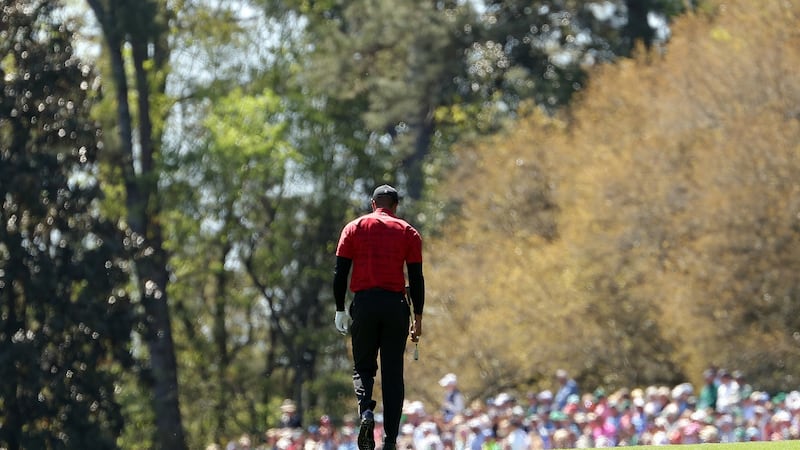A winner without winning, Tiger Woods – white teeth glistening as one smile after another was displayed in a round of 78 strokes – walked his way up the hill towards the 18th green, a perceptible limp part of who he is these days in a body with more screws and plates and rods than the fictitious Bionic Man, to roars of appreciation and a standing ovation from one and all gathered on the hillocks.
And, to his credit, Woods enjoyed it as much as kid thrown a surprise birthday party. Although he missed his birdie putt on the last, tapping in for a par, the grin was ever-present as he left the putting surface and headed to the recorder’s hut.
This was akin to his “Hello world” moment at the start of his professional odyssey back in 1996, where it was all about soaking it all in and enjoying every step of the journey.

In this latest comeback, it was not about claiming a 16th Major or a sixth Masters title. It was about competing, of playing all four rounds.
And while he may have gone into the tournament with the belief that he could win, the reality – for a player competing with a scorecard in his back pocket for the first time since his serious car crash of February 2021 – was about getting back out on a golf course again and being an integral part of a tournament.
Where will we see him again? Most likely at the US PGA Championship at Southern Hills in Tulsa, Oklahoma, next month. Then at the US Open at Brookline outside Boston in June. And, definitely at the 150th Open championship at St Andrews in July. By then, Woods may even truly think he has a chance to win.
For now, completing 72 holes at Augusta National, a favoured place, must go down as another monumental achievement for Woods given the path he has taken since that car crash which at one point had surgeons considering a partial amputation of his right leg.
As Jon Rahm, his own Masters quest put on the back burner, described accompanying Woods through the final round: "It was really cool, because nobody cared about me. I was just watching him play, it was [like being] one more spectator . . . . I was able to enjoy as a fan and as a player. You can just tell his leg is just not quite up there yet. He is limping on the course.
“He is trying very hard to play, but it is not easy to walk up and down those hills. At the end you can just tell that his leg and his body are not used to walking this much, right? This is the hardest walk all year. He will be able to go somewhere where it’s a little easier, it won’t be as long, and I believe he’ll be able to contend.”
In truth, Woods’s ability to play all four rounds – 71-74-78-78 – was all about reminding us of his fortitude and resilience and perhaps providing an indication, as Rahm pointed out, of contending in future Majors down the road.
Tough road
Of his latest comeback and how he got there, Woods observes: “I don’t think people really understand. The people who are close to me understand. They’ve seen it. Some of the players who are close to me have seen it and have seen some of the pictures and the things that I have had to endure. They appreciate it probably more than anyone else because they know what it takes to do this out here at this level.
“It’s one thing to play with my son [Charlie] at a hit-and-giggle, but it’s another thing to play in a Major championship. It’s been a tough road, and one that I’m very thankful to have the opportunity to be able to grind through it. A lot of different things could have happened, but 14 months [on], I’m able to tee it up and play in the Masters.”
Woods further explained: “I don’t quite have the endurance that I would like to have had, but as of a few weeks ago, I didn’t even know if I was going to play in this event. To go from that to here, we’re excited about the prospects of the future, about training, about getting into that gym and doing some other stuff to get my leg stronger, which we haven’t been able to do because it needed more time to heal. I think it needs a couple more days to heal after this, but we’ll get back after it, and we’ll get into it.”
Woods has talked of how he has worked pretty much every day, with physios and personal trainers, to get to the point where he could play again. That journey is an ongoing process.
“It’s hard. I have those days where I just don’t want to do anything. It just hurts, but I’ve had a great team around me that are super positive and have motivated me and helped me around. It’s those days that are tough. There have been more tough days than easy days. I just have to work through it, and like golf, in order to get better, you just have to go out there and put in the time.
“ I think the hard part are the recovery sessions. Hopping in those ice baths, doing those a number of times a day, those do really suck, but it works . . . . I will try to get ready for [the PGA at] ) Southern Hills and see what this body can do.”

















